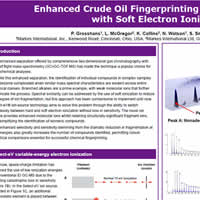Resumo do Pôster:
1. Introduction
Crude oil contains thousands of organic compounds ranging from light hydrocarbons to complex biomolecules. In the past, such complex samples were analysed by chemical fractionation followed by one-dimensional gas chromatography with mass spectrometry. However, fractionation is a time-consuming, labour-intensive process, which uses large volumes of solvents and can be prone to error. GC×GC–TOF MS is now used routinely in the oil industry to overcome this problem.1 Despite the superior separation afforded by GC×GC, the identification of individual compounds with similar spectra at conventional 70 eV ionisation energies, as the branched alkanes, with weak molecular ions is challenging. Spectral similarity can be addressed by the use of soft ionisation to reduce the degree of ion fragmentation, but this approach has been cumbersome to implement until now.
In this study, a new variable-energy electron ionisation technology that enhances analyte speciation by providing additional data on both molecular ions and structurally significant fragments in the low-energy mass spectra is presented. The enhanced sensitivity and selectivity stemming from the dramatic reduction in fragmentation at low energies also greatly increases the number of compounds identified, permitting robust statistical comparisons essential for successful chemical fingerprinting.
2. Purpose
Present a MS source technology that enables automated variable ionization energy that enhances compound identification of crude oil sample without compromising sensitivity.
3. Method
A gas chromatograph equipped with a Zoex ZX1 loop modulator was used in combination with a time-of-flight mass spectrometer with ion-source technology that allows the energy of electron ionisation to be varied. GC×GC separations were conducted using a conventional apolar–polar column set, using a 100 mg/mL dilution of crude oil in dichloromethane. Column set: DB-5 (28 m × 0.25 mm × 0.25 µm) in the 1st dimension and SGE BPX50 (2.3 m x 0.1 mm x 0.1 µm) in the 2nd dimension. Modulator delay loop: 1.0 m, as for 2nd dimension; Modulation time: 6 s.
4. Results and Discussion
A comparison of the crude oil colour plots at 70 eV and 14 eV showed an improvement in selectivity at the lower-energy ionization, particularly within the aliphatic region, due to dramatically reduced fragmentation of these compounds within the ion source. The enhanced selectivity provided by low-energy ionization allowed the automated detection of over 1000 additional ‘blobs’ in the 14 eV GCxGC colour plot, compared to the same sample run at 70 eV.
The presence of only structurally-significant mass spectra leads to a reduced demand on dynamic range and an increase in peak capacity for GCxGC-TOF MS. Furthermore, the ability to provide enhanced molecular ions whilst retaining structurally-significant fragment ions allows for greater orthogonality between the mass spectra of isomeric compounds, thus simplifying compound identification.
This source technology of electron ionization at low energy can also aid the identification of crude oil biomarkers. Figure 1 compares the 70 eV and 14 eV mass spectra for two sterane-type biomarkers in the crude oil. In both cases, the mass spectra at low energies have reduced fragmentation, as well as enhanced molecular ion signals, resulting in improved signal-to-noise values and lowered limits of detection. However, unlike other soft ionisation techniques that produce a sole molecular ion, the technology presented retains significant fragments that can aid structural elucidation.
5. Conclusion
The electron ionization at low energy provides improved sample characterization for the complex crude oils, by reducing fragmentation and increasing molecular ion response, with no inherent loss in sensitivity. The extra information provides more robust statistical comparisons for chemical fingerprinting of whole oils.
By suppressing the fragmentation at low ionization energies, matrix interferences are greatly reduced. Furthermore, carrier gases and/or residual background gases are not ionized, due to their higher ionization potentials. Therefore, the signal-to-noise ratios for target substances are dramatically improved, allowing lower limits of detection to be achieved.
6. References
- von Mühlen, C.; Zini, C.A.; Caramão, E.B.; Marriott, P. Applications of comprehensive two-dimensional gas chromatography to the characterization of petrochemical and related samples. Journal of Chromatography A, 1105 (2006) 39–50.
|

